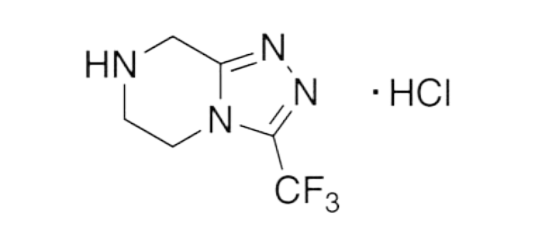Pyrimidine Hydrochloride: The Key Synthetic Intermediate of Sitagliptin
Tag:Industry News

3-(Trifluoromethyl)-5,6,7,8-Tetrahydro-[1,2,4]triazolo[4,3-a]pyrazine Hydrochloride (CAS: 762240-92-6), commonly abbreviated as pyrazine hydrochloride, is an organic compound with the chemical formula C6H8ClF3N. It has a molecular weight of 228.6, a melting point of 236-246°C, a boiling point of 266.2°C, and a flash point of 114.8°C. In the laboratory, it typically exists as a white crystalline solid.

Chemical Formula
Pyrazine hydrochloride is a key intermediate in the synthesis of Sitagliptin, an oral medication used to treat type 2 diabetes.

Preparation of Pyrimethamine Hydrochloride
The preparation method of pyrimethamine hydrochloride involves complex organic synthesis processes, requiring precise operations and condition controls to ensure the quality and availability of the final product. The following are the main synthesis processes of pyrimethamine hydrochloride.
1. Glycine methyl ester is reacted with 2-(N-tert-butoxycarbonyl)aminoacetaldehyde via reductive amination, with benzyloxycarbonyl chloride protecting the secondary amine. Under acidic conditions, the tert-butoxycarbonyl group is removed, cyclization occurs under the action of trimethylaluminum, followed by deprotection through hydrogenation, methylation, cyclization, and other reactions to obtain the desired compound.

2. Chloropyrimidine is used as a starting material, which undergoes hydrazinolysis with hydrazine hydrate, trifluoroacetic anhydride acylation, polyphosphoric acid cyclization, and palladium carbon catalyzed hydrogenation reduction.

3. Starting with ethyl trifluoroacetate, hydrazine hydrate, and ethyl chloroacetate, hydrazinolysis is initiated, followed by cyclization with phosphorus oxychloride, nucleophilic substitution with ethylenediamine, and cyclization with hydrochloric acid and methanol.

Downstream applications of pyrimidine hydrochloride


Drug Synthesis
Pyrimidine hydrochloride, developed by Merck & Co. in the United States, plays a crucial role in the synthesis of sitagliptin. As the first dipeptidyl peptidase-4 (DPP-4) inhibitor, sitagliptin is commonly used in clinical applications in the form of phosphate salts. Its primary functions include the prevention and treatment of type 2 diabetes, hyperglycemia, insulin resistance, obesity, hypertension, and certain complications, holding significant clinical significance for patients with type 2 diabetes.
The development history of sitagliptin
October 200 | Approved for listing by US FDA |
January 2009 | Approved to land in China |
2017 | Enter the China medical insurance directory |
July 4, 2022 | Compound patent CN1290848C expires |
June 18, 202 | Crystal form patent CN100430397C expires |
According to data from the World Health Organization (WHO) in 2022, the global diabetic population has reached 537 million, with over 80% of deaths occurring in low- to middle-income countries. It is projected that by 2030, diabetes will become the seventh leading cause of death worldwide. Therefore, the market demand for pioglitazone hydrochloride is expected to gradually rise in the future, with immense potential for industrial development and promising prospects.
PS:
If you plan to purchase pyrazine hydrochloride products, please contact us (email: Sales@dachenpharm.com) and tell us your usage scenarios and pain points. We can provide industry-leading consulting services and the best customized solutions. You are also welcome The majority of pharmaceutical dealers contact us for cooperation and promotion.

Ethylene glycol – an Overview


